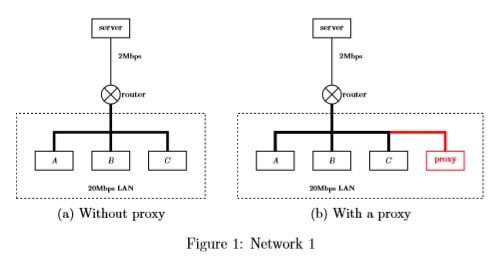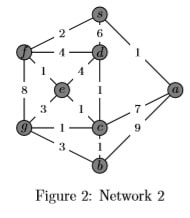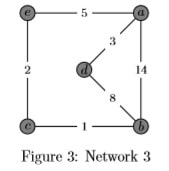SEEM5770/ECLT5840 open systems/electronic commerce
{`The Chinese University of Hong Kong
Department of Systems Engineering and Engineering Management
`}
Assignment 1: Networking
Q-1: Consider the following scenario which is demonstrated in Figure 1a: Users A, B and C are in an institutional network with 20Mbps LAN. A server that holds two web pages, namely, “homework.html” and “project.html”, is connected to the institutional network with a 2Mbps link. The “homework.html” and “project.html” are both of size 1M bits. Specially, “homework.html” references 3 figures, each of which is 0.3M bits. The server supports only non-persistent HTTP. To download an object from the server, it needs totally 20,000 bits (including requests and responses) to create a TCP connection. A HTTP request is 10,000 bits, and a HTTP response is 10,000 bits plus the size of the object contained. Processing delay, queuing delay, and propagation delay are assumed to be 0 in this question.
- What is the total time for user A to download “homework.html” and then “project.html”?
- After A has finished, how much time it takes for B to download “homework.html” and then for C to download “project.html”?
- If a proxy server is installed for the institutional network (see Figure 1b), what is the total time for user A to download “homework.html” and then “project.html”? Compare with (a).
- After A has finished, how much time it takes for B to download “homework.html” and then for C to download “project.html” provided the proxy server is present, comparing with the question (b)?

Q-2: Given all the fields but the checksum field of a UDP segment shown in Table 1, calculate the checksum field. The structure of Table 1 is as follows: the first two lines are the header of the segment, while the remaining two lines are payloads in the segment.
|
0000 0000 0000 0101 |
0000 0000 0010 0011 |
|
0000 0000 0010 0000 |
checksum |
|
1000 1001 0101 0011 0111 1111 0011 0000 | |
|
1010 1101 0100 0111 1111 0101 0000 1110 | |
Table 1: A UDP segment with checksum unknown
Q-3: Consider a reliable data transfer protocol that uses only negative acknowledgments (NAK). Suppose the sender sends data only infrequently. Would a NAK-only protocol be preferable to a protocol that uses ACKs? Why?

Q-4: Consider the network shown in Figure 2. With the indicated link costs, use Dijkstra’s shortest-path algorithm to compute the shortest path from s to all network nodes. Show how the algorithm works by computing a table similar to the table shown in the lecture note of Chapter45th.ppt slide 4-21. And show the forwarding table for the router represented by s.

Q-5: Consider the network shown in Figure 3. Assume that each node initially knows the costs to each of its neighbors. Following the distance-vector algorithm, show the steps to compute the distance tables until it is converged.
